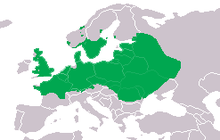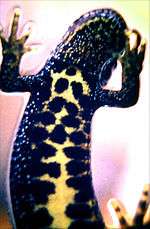Northern crested newt
| Northern crested newt | |
|---|---|
 | |
| Male great crested newt in "mating dress". | |
| Scientific classification | |
| Kingdom: | Animalia |
| Phylum: | Chordata |
| Class: | Amphibia |
| Order: | Caudata |
| Family: | Salamandridae |
| Genus: | Triturus |
| Species: | T. cristatus |
| Binomial name | |
| Triturus cristatus (Laurenti, 1768) | |
 | |
| Northern crested newt range | |
The northern crested newt, also known as the great crested newt or warty newt (Triturus cristatus) is a newt in the family Salamandridae, found across Europe and parts of Asia.
Description

It is a relatively large species. Females can measure up to 16 cm and are larger than males, which measure 14 to 15 cm long.[2]
These newts have dark grey-brown backs and flanks, and are covered with darker-coloured spots so they appear almost black. Their undersides are either yellow- or orange-coloured and are covered in large, black blotches, which have a unique pattern in each individual.
Males can be distinguished from females by the presence of a jagged crest during the breeding season. This runs along their backs, then a separate smoother-edged crest runs above and below their tails (in some other species of newts, the crest along the back is continuous with the tail crest). They also have a silver-grey stripe that runs along the tail.
Females lack a crest, but have a yellow-orange stripe along the lower edge of their tails and often a marked orange stripe along the top of their lower backs and tails.[3][4] The great crested newt is known for the long jagged crest on its back.Great crested newts are a protected and endangered species.
Distribution
The range of the northern crested newt extends from Great Britain and Brittany in the west, across much of Europe north of the Alps, and southeast to the Black Sea. It is the biggest and least common of the three newts found in the British Isles and is one of only four amphibians which are protected by the UK Biodiversity Action Plan.
Several closely related species were formerly considered to be subspecies of the northern crested newt: the Italian crested newt (Triturus carnifex), the Danube crested newt (Triturus dobrogicus) and the southern crested newt (Triturus karelinii). These are now recognized as separate species of the Triturus cristatus species complex.[1]
Conservation status
Since the 1940s, populations of northern crested newts have declined in most of Europe due to loss of habitat.[5] In England, Wales, and Scotland, it is a protected species under Schedule 5 of the Wildlife and Countryside Act 1981, and under equivalent legislation in Northern Ireland. It is also a European Protected Species and as such it has additional protection in the UK under Regulation 39 of the Conservation (Natural Habitats etc.) Regulations 1994 (the Habitats Regulations), as amended by the Conservation (Natural Habitats, &c.) (Amendment) Regulations 2007. It is an offence to:
- Intentionally kill, injure or take a northern crested newt
- Possess or control any live or dead specimen or anything derived from a northern crested newt
- Intentionally or recklessly damage, destroy or obstruct access to any structure or place used for shelter or protection by a northern crested newt (in practice this means both its breeding sites and its terrestrial habitat)
- Intentionally or recklessly disturb a northern crested newt while it is occupying a structure or place which it uses for that purpose
Other EU countries have similar legislation, implementing the Habitats Directive.
In the United Kingdom, its habitat has diminished due to land development pressure from population growth and agricultural expansion; for example, it is considered eliminated from its prior range at the Portlethen Moss Nature Reserve in Scotland.
Where development activities may interfere with its populations, exclusion systems such as newt fencing may be put in place to prevent the newts from entering a development site. Newt fencing may also be used to create a receptor site or 'newt-safe' area to where northern crested newts can be translocated, from an area where they are under threat.
In the UK, guidance on development in relation to northern crested newts can be found in Natural England's Great Crested Newt Mitigation Guidelines which should be followed by developers.[6]
Behaviour
Northern crested newts normally live on land, but breed in ponds and pools. Breeding is similar to that of other newts. After performing a courtship display, the male deposits a spermatophore (a small packet of sperm) from his cloaca (reproductive and excretory opening) in the path of the female. He then moves sideways in front of her to gently encourage her into a position where the spermataphore will be pressed against and picked up by her cloaca—so "mating" is done without direct contact. The female lays two or three eggs a day between March and mid-July, until 200 to 300 eggs have been laid. The eggs are laid on submerged aquatic plants, each carefully wrapped in a leaf.
The larvae hatch after about three weeks, and then live in the pond as aquatic predators. They are vulnerable to fish predation, and water bodies containing fish are rarely used for breeding (this means they do not usually use running water, larger lakes, nor many garden ponds).
After metamorphosis into air-breathing juveniles (or "efts") at about four months old, they live terrestrial lives until old enough to breed, which is at about two or three years of age. They may disperse at this age as far as 800 m (about 0.5 mi).
Both the juvenile newts and the adults (outside the breeding season) live in terrestrial habitats with dense cover, such as scrub, rough grass, and woodland, usually within about 200 m of the breeding pond. They rest during the day beneath rocks, logs, or other shelter.
Larval newts usually feed on tadpoles, worms, insects and insect larvae. Adults hunt in ponds for other newts, tadpoles, young froglets, worms, insect larvae, and water snails. They also hunt on land for insects, worms, and other invertebrates.[4]
Throughout October to March, they hibernate under logs and stones or in the mud at the bottom of their breeding ponds.[4] The newts normally return to the same breeding site each year, and can live as long as 27 years, although up to about 10 years is more usual.
See also
| Wikispecies has information related to: Triturus cristatus |
| Wikimedia Commons has media related to Triturus cristatus. |
References
- 1 2 "Triturus cristatus (Great Crested Newt, Northern Crested Newt)". iucnredlist.org. Retrieved 2013-01-17.
- ↑ The characteristics of great crested newt Triturus cristatus breeding ponds
- ↑ Great crested newt - Triturus cristatus - Information - ARKive. Retrieved 14 April 2009
- 1 2 3 BBC - Science & Nature - Great Crested Newt. Retrieved 2014-9-10
- ↑ Cheshire region Biodiversity Partnership: Species Action Plans: Great Crested Newt. Retrieved 2009-04-14
- ↑ Natural England PDF
